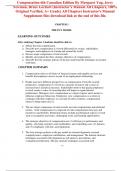Compensation 6th Canadian Edition By Margaret Yap, Jerry
Newman, Bruce Gerhart (Instructor's Manual All Chapters, 100%
Original Verified, A+ Grade) All Chapters Instructor's Manual
Supplement files download link at the end of this file.
CHAPTER 1
THE PAY MODEL
LEARNING OUTCOMES
After studying Chapter 1 students should be able to:
❑ Define the term compensation.
❑ Describe how compensation is viewed differently by society, stakeholders,
managers, and employees in Canada and around the world.
❑ Discuss major components of total rewards.
❑ Identify and explain the three strategic objectives of compensation.
❑ Describe the four strategic policies in the pay model and the techniques associated
with them.
CHAPTER SUMMARY
1. Compensation refers to all forms of financial returns and tangible services and
benefits that employee receive as part of an employment relationship.
2. People may have different perspectives on compensation. From the societal
perspective, compensation is viewed as a measure of justice and a cause of
increased taxes and price increases. Stakeholders believe that paying employees
in stock creates a sense of ownership that will improve organizational
performance. Managers view compensation as a major expense and a means to
influence employee behaviour. Employees view compensation as a return in
exchange with their employer, or a reward. In other countries, compensation
relates to being taken care of.
3. The two major components of total rewards are total compensation and relational
returns. Total compensation is composed of cash compensation (base pay and
incentives) and benefits. Relational returns include psychological aspects of work
such as recognition and status, challenging work, and learning opportunities.
4. The strategic objectives of compensation are (1) efficiency in performance and
quality, satisfying customers and stockholders, and controlling costs, (2) fairness,
and (3) compliance with laws and regulations.
5. The four strategic policies in the pay model are internal alignment, external
competitiveness, employee contributions, and management. The internal structure
techniques associated with alignment are job analysis, descriptions, and
evaluations/certification. The pay structure techniques associated with
1-1
Yap, Compensation, 6th Canadian Edition
© 2021 McGraw Hill
, competitiveness are market definitions, surveys, and pay policy lines. The
incentive program techniques associated with contributions are seniority-based,
performance-based, and merit guidelines. The evaluation techniques associated
with management are planning, budgeting, and communication.
LECTURE OUTLINE
COMPENSATION: DEFINITION
• Compensation refers to all forms of financial returns and tangible services and
benefits that employee receive as part of an employment relationship.
WHY SHOULD WE CARE ABOUT COMPENSATION?
• Compensation influences the way employees behave.
• The link between behaviour and organizational effectiveness is important to
consider.
• If employees believe that compensation is not fair, there is potential for behaviour
that undermines organizational performance.
• Compensation is a significant component of operating expenses and therefore
must be controlled and monitored to ensure organizational viability.
COMPENSATION: DIFFERING PERSPECTIVES
Compensation does not mean the same thing to everyone. Yet, how people view
compensation affects how they behave at work. It is important to recognize different
perspectives.
Compensation refers to all forms of financial returns and tangible services and benefits
that employees receive as part of an employment relationship.
Society perceives compensation as a measure of justice (distributive).
See Exhibit 1.1 – Overviews the gender wage gap in median earnings of full-time
employees
Stockholders view executive pay as a special interest. In Canada, pay for executives is
supposed to be tied to the financial performance of the company. Unfortunately, this
does not always happen.
Managers view compensation as both an expense and an influence on employee work
behaviour.
1-2
Yap, Compensation, 6th Canadian Edition
© 2021 McGraw Hill
,Employees view compensation as a return for the work they perform.
Global views of compensation differ around the world. For example, in China, the
traditional characters are based on the signs for logs and water, provides the necessities in
life. The word dai yu refers to how someone is being treated. In Japan, the word kyuyo is
used for compensation, which means giving something.
See Exhibit 1.2 – Overviews hourly compensation costs for production workers in
manufacturing and economy-wide productivity (GDP) per employed person), in U.S.
dollars.
FORMS OF PAY
There are numerous forms of pay that collectively create a system of total rewards.
See Exhibit 1.3 – Overviews forms of pay
Total rewards are all rewards received by employees, including:
1. cash compensation,
2. benefits and
3. relational returns: psychological returns employees believe they receive in the
workplace.
A) Cash Compensation
1) Base Pay
a) Wage is the pay expressed at an hourly rate.
b) Salary is the pay expressed at a monthly or annual rate.
2) Merit increases are given as an increment to the base pay in order to recognize
past work success. Cost-of-living adjustment gives the same percentage increase
across the board to everyone, regardless of performance, in order to maintain pay
levels relative to increases in the cost of living.
3) Incentives/Variable Pay means one-time payments for meeting pre-established
performance objectives in a future time period.
4) Long-Term Incentives are intended to focus employee efforts on multi-year
results. Incentives may be short or long term.
B) Benefits
Benefits are indirect compensation which includes health insurance, dental insurance,
pensions, and life insurance. These help protect employees from the financial risks
inherent in daily life.
1) Insurance and Pensions include those legislated by law (CPP/QPP, EI and
Workers’ Compensation) and those provided by the employer (company pension,
health insurance, and life insurance).
2) Work/Life Programs help employees better integrate their work and life
responsibilities including time away from work (vacations, jury duty, drug
counselling, financial planning, referrals for child and elder care, flexible work
arrangements).
1-3
Yap, Compensation, 6th Canadian Edition
© 2021 McGraw Hill
, 3) Allowances are compensation to provide for items that are in short supply.
C) Relational Returns
Relational returns are the psychological returns employees believe they receive in the
workplace, like the following:
1) Recognition and Status
2) Employment Security
3) Challenging Work
4) Learning Opportunities
Total Earnings
Compensation decisions offer temporary motivation. The present value means there is a
low initial offer in consideration of future income.
Relational Returns
Non-financial returns affect employees such as recognition, status, employment security
etc.
The Organization as a Network of Returns
It is useful to think of an organization as a network of returns created by all of these
different forms of pay.
A PAY MODEL
The Pay Model contains three basic building blocks:
1) Strategic Policies
2) Techniques
3) Strategic Objectives
See Exhibit 1.4 – Overviews the Pay Model
STRATEGIC COMPENSATION OBJECTIVES
1) Strategic Compensation Objectives shape the pay system and serve as the standard
for evaluating the pay system.
1. Efficiency improves performance, quality, delighting customers and stockholders
and controlling labour costs.
2. Fairness attempts to ensure fair pay treatment for all employees by recognizing
employee contributions and employee needs. Procedural fairness is the fairness
of the process used to make a decision.
3. Compliance as a pay objective involves conforming to various federal,
provincial and territorial compensation laws and regulations.
1-4
Yap, Compensation, 6th Canadian Edition
© 2021 McGraw Hill






